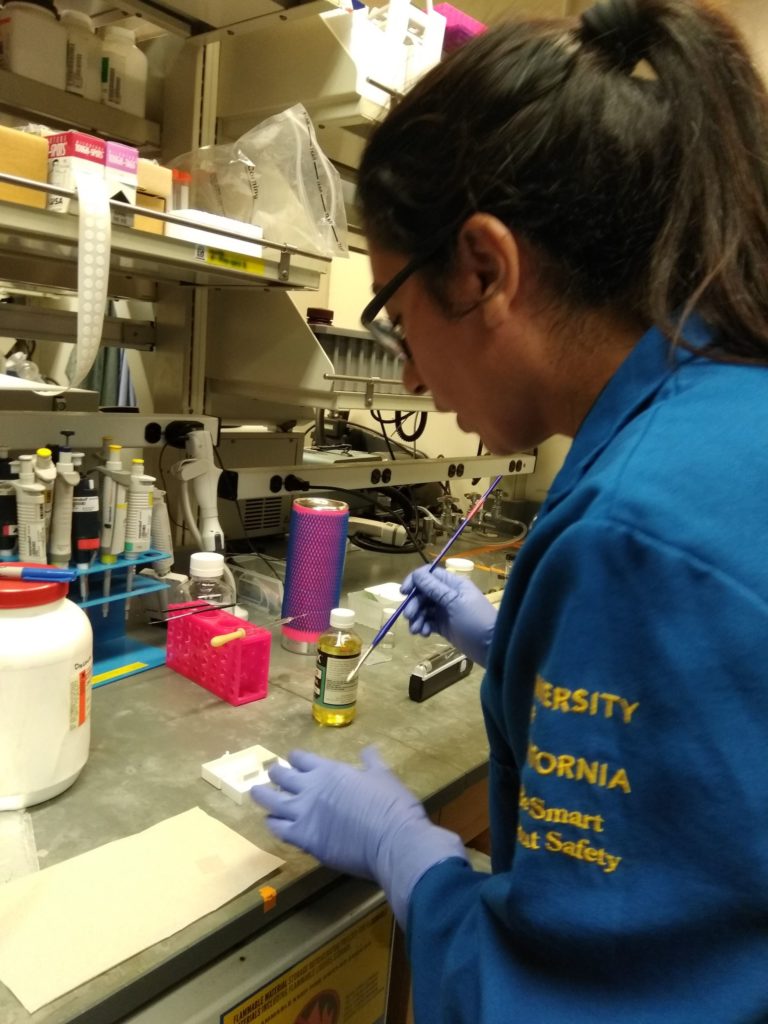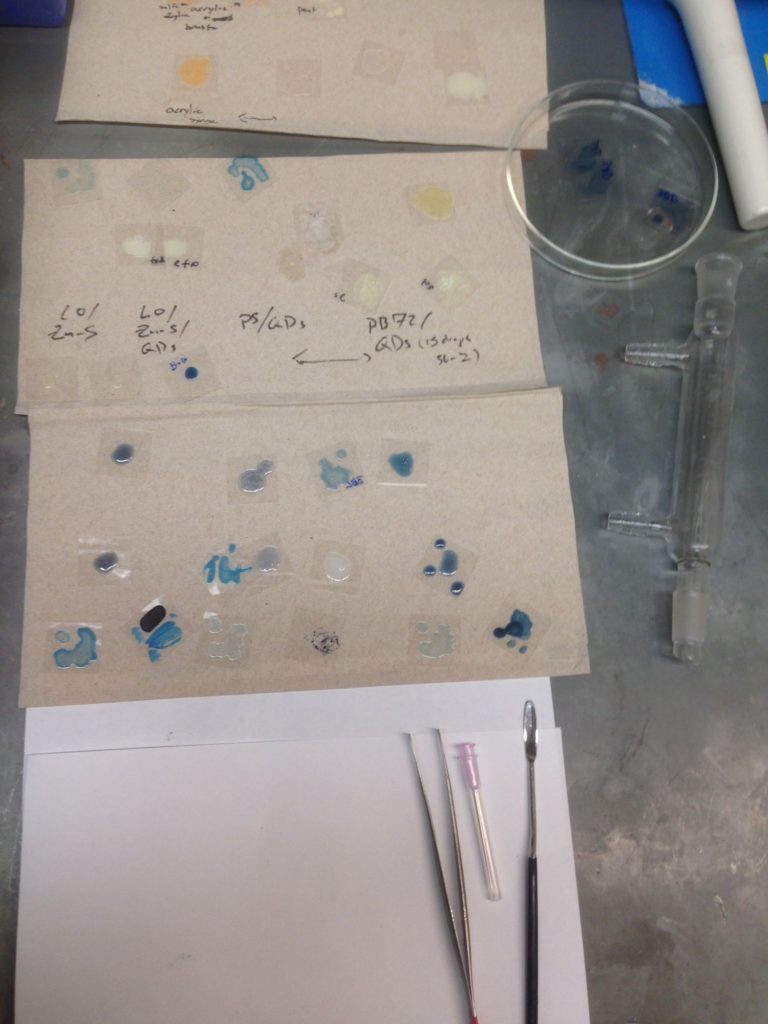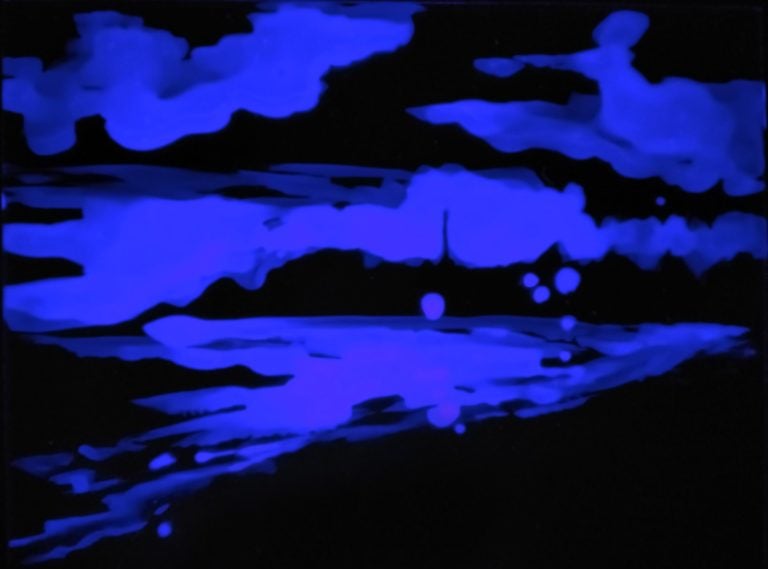On Thursday 30 August, 2018 a new colour was introduced to the world – a shade of blue that is believed to be the purest form of the colour. That is at least what
Olga Alexopoulou, the pigment’s creator, claims. The Istanbul-based artist travelled all the way to Berkeley California to work on this project in one of the world’s most renowned scientific laboratories, the exact place where plutonium, dark energy and the acceleration of the universe were discovered. Because Quantum Blue, as its name suggests – the pigment that Olga calls “the blue of the future” – is the outcome of a meeting of nanoscientific principles and art. The pigment is made out of quantum dots and is blue in both absorption and luminescence. The purity of the colour of quantum dots makes them the purest colour phosphors one can find. But for Olga, this is less chemistry and more alchemy, as this project allowed her to capture ‘the blue hour’.
Speaking to Neos Kosmos, she shared this groundbreaking scientific and artistic experience.
How did this project come to be?
Over a dinner party, I heard a professor talk about these Quantum dots and how fantastic their optical qualities are. They were invented back in 1980, but no-one knows about them – apart from the scientists using them. So, I decided to research them further because I thought this is something that needs to be used in art. I contacted my friend, the great colour expert Maria Chatzidakis, who first thought this sounded like a science fiction scenario but luckily, agreed to help me. I then sent an email to Professor Paul Alivisatos, an internationally recognised authority on the fabrication of nanocrystals (which is what Quantum dots are). I didn’t really think that Professor Alivisatos would respond to my email, given he is considered among the top five chemistry experts in the USA, among other distinctions. But he did and we started the project within a couple of days. He assigned two nanotechnology scientists, Arunima Balan and Joseph Swabeck to implement the materials at Lawrence Berkeley National Laboratory in California.
What are quantum dots?
Quantum dots are sometimes called artificial atoms; they are particles so small that they abide by the rules of quantum mechanics, hence their name. What interests us, however, in this endeavour, is their purity of colour. The purity of their colour makes them the purest colour phosphors one can find.
How was your first day at the lab?
The first morning was magnificent because the laboratory, which is perched on a hill above Berkley, was covered in mist and this made it look even spookier, if that’s possible. As we were walking around with Maria Chatzidakis, we were recounting all the inventions that have taken place there, like the discovery of plutonium, dark energy and the acceleration of the universe. I think what has left an impression on me was a safety instruction to “treat every surface as contaminated”. Of course, when we got to work, it was very beautiful to actually see quantum dots in a vial for the first time with my own eyes. Under natural light, they look white or yellowy, but with a magical iridescence and radiant blue under UV light.

Olga in the lab.



How can an artist lead a science project?
By saying things like “can we make it less purple!” I have worked with blue pigments for years, historical and contemporary, so I knew what I wanted the final visual outcome to be. Maria has worked with the chemistry of pigments throughout history and Arunima and Joseph have the know-how with the quantum dots, so everyone was bringing a different and very useful skill to the table.
How has this experience affected the way you think?
One of the things I enjoyed immensely about the process was walking around Istanbul, where I live, and thinking – or day dreaming if you like – about how to make Quantum Blue. I think the fact that this daydream came true has shown me that we as artists – or people – can do so much more!
What is it like, to create a new colour?
The creation of a new pigment was particularly magical with Quantum Blue because of its special glow. The photographs don’t really capture it, but in natural light, it is an intense blue, and under UV light, the special blue glow – characteristic of the quantum dots inside it – takes effect. There is also a slight iridescence when seen on softer UV light.
What was the first work you created with Quantum Blue?
The whole summer that I was planning the trip to California, my mind was fixated on a particular time, the ‘blue hour’ as it is called, which is the time just after sunset. In particular how the sky looks from a beach on the Greek island of Aegina that I know very well since I was a kid. So, when I was in Berkley at the lab and the time came to make the first painting, the scientists cleared some room for me in the laser room, and my mind was flooded by this very familiar blue light that falls on the beach just before the night starts.

What does this colour mean to you?
I think blue and I have a genetic relationship. I was born being magnetised by blue. I can’t really explain it; it draws me in.
How has Greece affected your perception of blue?
I think life in Greece is very intertwined with the sea. Anything from real life to literature and art is soaked with saltwater. So just observing this massive body of different blues has definitely shaped the way I think.
* Olga Alexopoulou will showcase her work with Quantum Blue – and the painting she created with it – in her upcoming solo show at UltraSuperNew gallery in Tokyo (https://gallery.ultrasupernew.com/), scheduled for March 2019.









